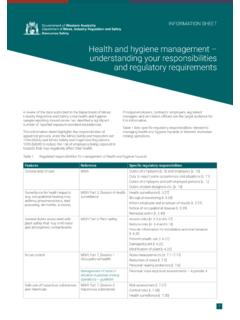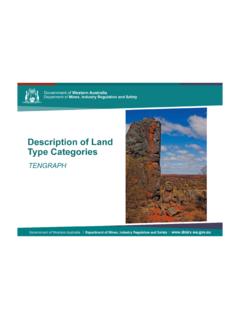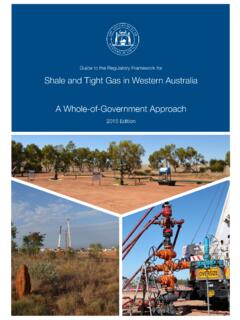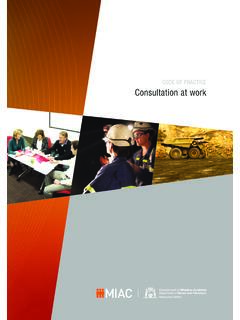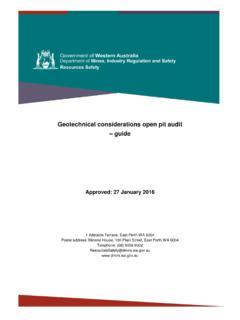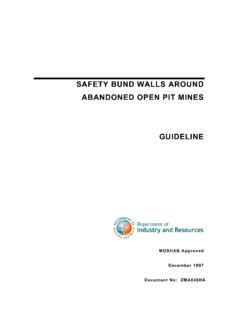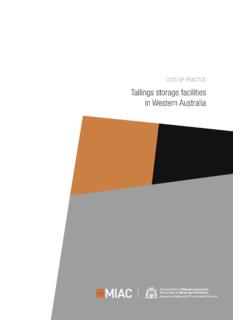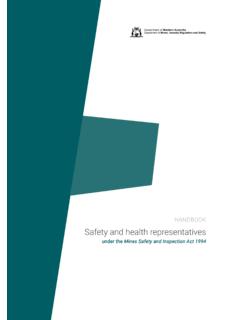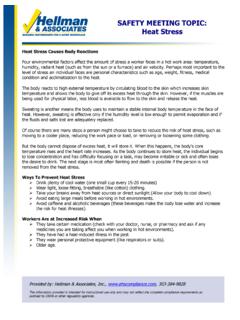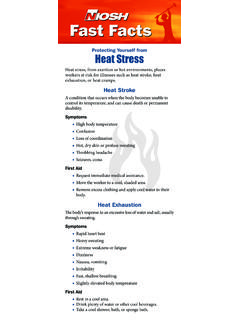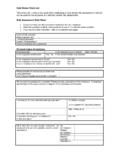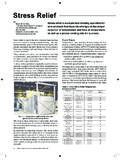Transcription of MANAGEMENT AND PREVENTION OF HEAT …
1 MANAGEMENT AND PREVENTION OF. heat stress . GUIDELINE. MOSHAB Approved December 1997. Document No: ZMR002SX. Department of Industry and Resources MANAGEMENT and PREVENTION of heat stress Document No. ZMR002SX Guideline CONTENTS. PAGE. REGULATORY 1. 2. heat stress 3. EFFECTS OF THERMAL stress ON THE BODY ..6. 4. METHODS FOR REDUCING heat stress (LOAD)..7. 5. EVALUATION OF heat stress (LOAD) ..8. 6. MINIMISING THE POTENTIAL FOR heat REFERENCES ..12. APPENDIX A. Assessment of Urinary Chloride (Fantus Test) ..13. APPENDIX B. Acclimatisation APPENDIX C. Commonly Used heat APPENDIX D. Example of heat Exposure TLV (ACGIH) ..17. APPENDIX E. heat Gain/Loss Issued: December 1997 Page 1. Version MANAGEMENT and PREVENTION of heat stress Department of Industry and Resources Guideline Document No.
2 ZMR002SX. FOREWORD. This Department of Industry and Resources guideline offers a practical approach for mine managers and supervisors to assist with managing employees working in hot environments. The acclimatisation and evaluation procedures listed in the body of this guideline are not regulations and compliance with them is not mandatory. However, adherence to the recommended procedures should ensure a high level of worker health protection. Acclimatisation and evaluation procedures different from those set out in the guideline may also be acceptable. In preventing heat strain, the importance of ensuring that employees appreciate the need for water intake, proper clothing and the need to be able to recognise early signs of distress cannot be over-emphasised. Comments on, and suggestions for, improvements to the guideline are encouraged.
3 The guideline will be revised as appropriate, to accommodate comments and to reflect legislature changes, new information on improvements in technology and operational experience. Comments should be sent to: State Mining Engineer Department of Industry and Resources 100 Plain Street EAST PERTH WA 6004. TEL: (08) 9222 3333. FAX: (08) 9325 2280. Page 2 Issued: December 1997. Version Department of Industry and Resources MANAGEMENT and PREVENTION of heat stress Document No. ZMR002SX Guideline REGULATORY FRAMEWORK. Provision in the Regulations for hot environments is covered in the Mines Safety and Inspection Regulations, 1995 as follows: Air temperature in workplaces (1) Each responsible person at a mine must cause all necessary measures and precautions to be taken to ensure that employees at the mine do not suffer harm to their health from the adverse effects of extremes of heat or cold.
4 (2) If conditions in any workplace are, or are likely to be, hot and humid, each responsible person at the mine must ensure that - (a) all employees are provided with training on measures to be taken to avoid any harmful effects from those conditions; and (b) appropriate workplace environmental controls (including ventilation) and monitoring are implemented; and (c) if appropriate, a program for monitoring the health of employees in the workplace is implemented. (3) In any workplace in an underground mine, and in any tunnel under a surge stockpile on the surface of a mine, each responsible person at the mine must ensure that - (a) if the wet bulb temperature exceeds 25 degrees Celsius, an air velocity of not less than metres per second is provided; and (b) any appropriate action referred to in subregulation (2) is implemented.
5 1. INTRODUCTION. There are great variations in temperature found in Western Australia from the cool areas in the South West to the high summer temperatures in the North and inland areas. The effects of heat may be encountered during: work in confined workplaces without adequate ventilation;. work where there is direct exposure to solar radiation;. work in hot and humid conditions;. work performed in the vicinity of hot sources such as furnaces, heaters and ovens;. Issued: December 1997 Page 3. Version MANAGEMENT and PREVENTION of heat stress Department of Industry and Resources Guideline Document No. ZMR002SX. heavy physical work in moderately hot and humid conditions ( such as in some underground mines);. work situations where protective clothing has to be worn; and any situation where an employee has previously shown signs of heat related effects ( dizziness, fainting and heat cramps).
6 Working in high heat environments can put workers at risk of impaired performance, heat illnesses and heat stroke. Impaired performance may result in unsafe acts and heat may also tend to promote accidents due to sweaty palms or impairment of vision through fogging of safety glasses. By way of further introduction this guideline refers to: heat stress - which is the burden or load of heat that must be dissipated if the body is to remain in thermal equilibrium. heat Strain - is the normal physiological or abnormal pathological change resulting from heat stress . The physiological condition referred to as heat strain is characterised by increases in deep body temperature, heat rate, blood flow to the skin and water and salt loss due to sweating. Most adverse effects arise from a failure of the body's cooling mechanisms or as a result of overloading of the system.
7 Normally, several physical and physiological mechanisms assure transfer of excess body heat to the environment. Even when the body is at rest, heat is generated by normal metabolism. With exercise, the heat produced by muscle activity rises rapidly. This generated heat is moved to the skin by the blood with the aim of transferring body heat to the environment. heat may then be lost through convection, evaporation of sweat, radiation and conduction. Page 4 Issued: December 1997. Version Department of Industry and Resources MANAGEMENT and PREVENTION of heat stress Document No. ZMR002SX Guideline To maintain the appropriate body temperature three issues are essential: The metabolic heat produced must be transferred to the skin via the circulation for dissipation;. The sweat glands must be able to produce the necessary amount of sweat; and The sweat must be able to evaporate.
8 Failure in any of these mechanisms for heat transfer may cause the body core temperature to rise, leading to heat strain and subsequent heat illness. Additionally, for the successful maintenance of the thermoregulatory system, adequate fluids must be consumed to prevent dehydration. When the air temperature is above skin temperature (around 36 C), evaporation of sweat is the main mechanism for the body to lose heat . 2. heat stress FACTORS. There are six factors influencing a persons capacity for heat exchange with the environment: Air temperature (dry bulb). Above 36 C the body can gain heat from the environment. Absolute humidity (wet bulb temperature). When the absolute humidity is high, evaporation of sweat is reduced, thereby reducing the body's opportunity to lose its heat .
9 Radiant heat from objects such as the sun, furnaces, and other hot surroundings. The direction of heat transfer depends on the absolute temperature difference between the body and the surrounding surfaces. It is not affected by the air temperature or humidity. Air movement. This can influence both convection and evaporation and can have a marked effect on heat exchange at the exposed skin surfaces (face, arms, legs). Convective heating or cooling does depend on the air temperature. Air movement assists with the evaporation of sweat from the skin and hence cooling capacity. Muscular activity. This is the most significant as it imposes a variable heat load. Work rates may increase heat production up to ten times the resting level and can cause a rapid body heat rise if this cannot be lost to the surroundings.
10 Issued: December 1997 Page 5. Version MANAGEMENT and PREVENTION of heat stress Department of Industry and Resources Guideline Document No. ZMR002SX. Clothing. This can have a major effect on the amount of heat transfer from the body. Clothing may limit convective exchange and may interfere with the body's capacity to lose heat through evaporation of sweat. However clothing can reduce the radiant heat to the body from surrounding surfaces (firefighters, furnace operators, underground motors and machinery). 3. EFFECTS OF THERMAL stress ON THE BODY. The body core temperature is significantly affected by body activities and by the ability of the body to lose this core heat . The extent of any rise is related to the physical work level. Skin temperature on the other hand depends on several environmental conditions.
